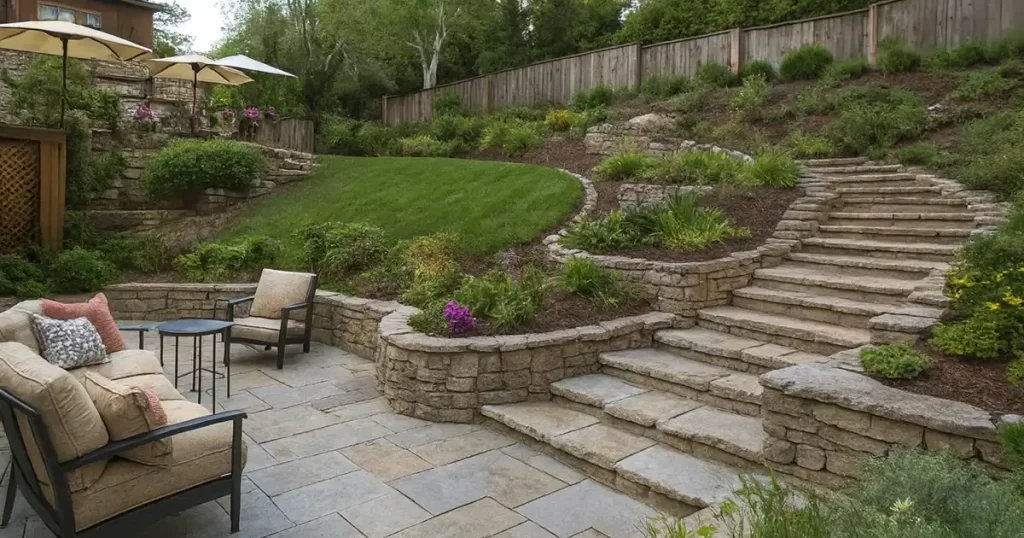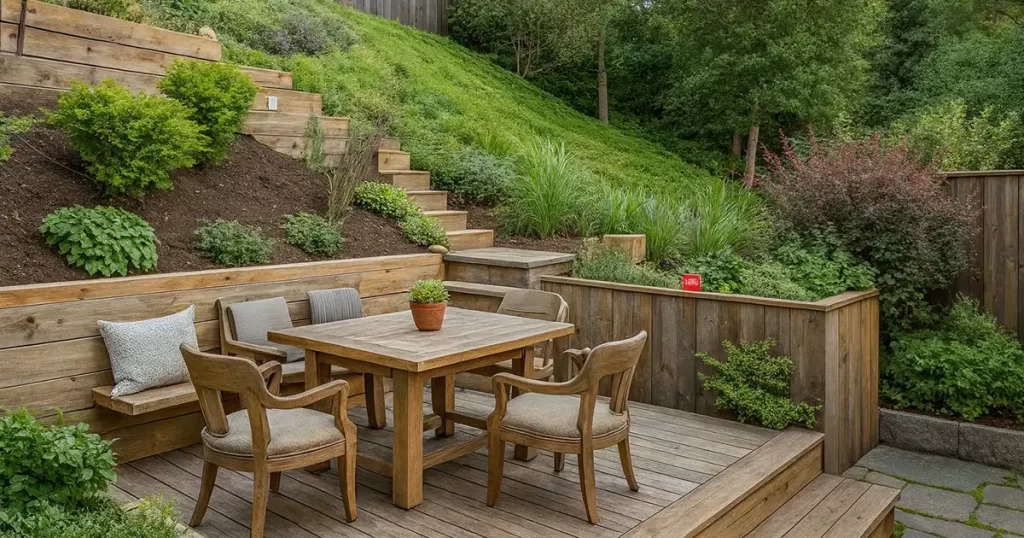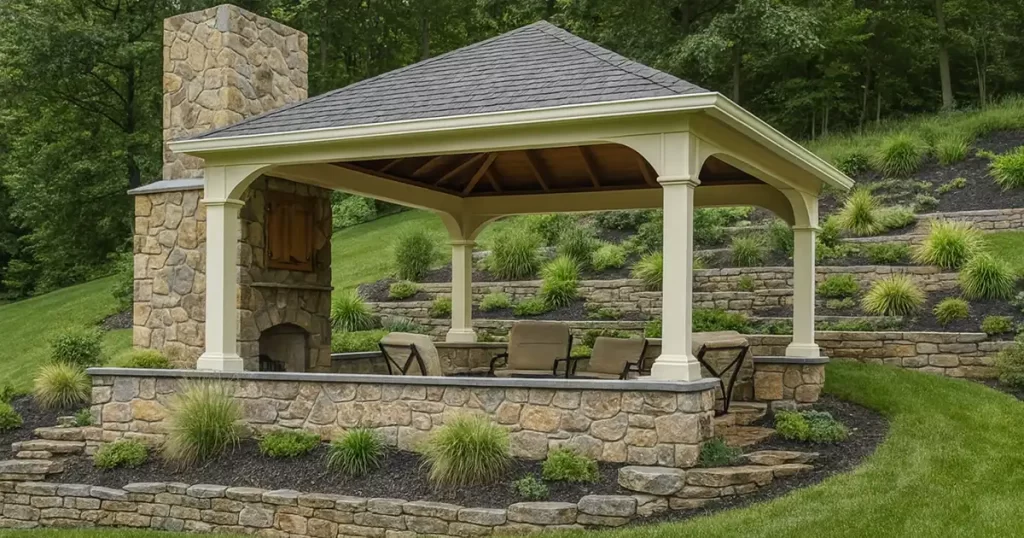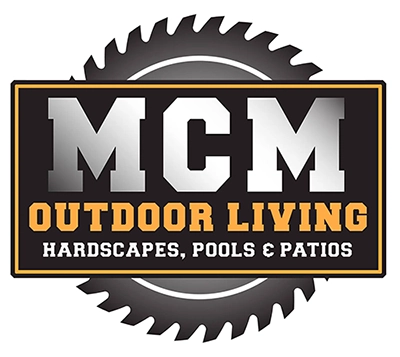
A sloped backyard can be tricky, but it also presents an opportunity. What looks like a difficult incline today could become your home’s most unique and rewarding outdoor space.
A slope doesn’t have to be a setback. With the right layout and materials, it can become one of the most useful and interesting parts of your yard.
Here are twelve ideas to help you reimagine what’s possible.
1. Understand the Landscape Before You Start
It sounds simple, but one of the most overlooked steps is observing how your yard naturally behaves. How steep is the slope? Where does rainwater go? Are there signs of soil erosion or compacted ground?
Take note of these things:
- Low points where water collects
- Areas with thin or dry soil
- Existing trees, shrubs, or rocks worth keeping
- Sun vs. shade patterns throughout the day
If you understand how your yard behaves makes it easier to plan where water should go, what needs support, and which plants are likely to do well.
2. Build Retaining Walls That Do More Than Hold Back Soil
A well-placed retaining wall can make a dramatic difference in how your yard feels and functions. These walls prevent erosion, define spaces, and let you create flat areas for patios, vertical garden beds, or lounging zones.
What’s great is that retaining walls don’t need to look purely functional. Use materials that match your home or landscape style, natural stone for a rustic look, concrete blocks for a modern edge, or timber for a warm, natural finish. Some walls even double as benches or feature built-in lighting.
The key is having a layout that feels integrated into the slope, rather than just stacked on top of it.
3. Terrace the Hill
Terracing works like steps down the hill, each level becomes a new opportunity. One tier might hold raised garden beds. Another could have a bistro table and chairs. The next might just be a spot for flowering groundcovers or ornamental grasses.
Terraces make a sloped area more accessible and easier to maintain, especially if your yard is too steep for a single retaining wall.
They also make a space feel larger and more inviting, giving the impression of a multi-room outdoor living area.

4. Use a Deck to Connect Home and Slope
If your house sits higher than your backyard, a custom deck can bridge the elevation change beautifully. An elevated or multi-level deck creates usable square footage that floats above the uneven ground.
It can serve as a dining space, a lounge area, or even a place for a hot tub with a beautiful view. And unlike trying to flatten your entire yard, a deck adapts to the slope without moving tons of soil.
Multi-tiered decks are especially effective. They follow the natural slope and create multiple zones for relaxing, cooking, or entertaining.
5. Lean Into the Rock Garden Look
If mowing your steep slope is more stress than it’s worth, consider going low-maintenance. A rock garden with drought-tolerant plants, gravel pathways, and large boulders is easy to care for, and great at controlling erosion.
Start with a few large rocks or feature stones, then build around them with native plants, succulents, or compact shrubs. Use crushed stone or mulch to fill gaps and keep weeds down.
The result is an earthy, modern look that works especially well on hills where nothing else seems to grow.
6. Choose Plants That Work for Slopes
The right plants can prevent erosion, add beauty, and minimize upkeep. Groundcovers like creeping thyme or sedum spread quickly and hug the soil. Deep-rooted natives hold ground in place during storms. And ornamental grasses provide movement and texture without needing much care.
Where traditional grass struggles to survive, native plantings often thrive, and look much better in the process. For shady slopes, go with hostas or native ferns. On sunny inclines, try black-eyed Susans, lavender, or little bluestem grass.
7. Add a Water Feature That Uses the Slope
Slopes make it easy to add movement, and what moves better than water?
A small stream, cascading fountain, or water feature that flows downhill takes advantage of gravity. You can also design a dry creek bed that handles water runoff after storms, protecting your landscape while adding texture and interest.
Framed by rocks and planted edges, water features bring calm and purpose to awkward corners of the yard.

8. Create One Solid, Flat Area
Sometimes, all a sloped backyard needs is one level section to feel livable.
Excavate a flat zone at the bottom or midway down the slope and use it for a brick patio, small lawn, or fire pit area. It becomes the centerpiece. The one spot where chairs sit flat, kids can run, or you can entertain without worrying about the incline.
A single level space can make the rest of the slope feel intentional, not accidental.
9. Make It Walkable
You don’t need to flatten the whole yard to make it usable. Sometimes, a few safe, well-placed paths and steps are all it takes.
Use stone, brick, or gravel for traction. Timber risers can work well on informal paths, especially when surrounded by greenery. Add handrails or edging for stability, especially on steeper parts.
10. Rethink the Lawn
Traditional grass doesn’t do well on steep grades. It’s hard to mow, dries out quickly, and doesn’t control erosion well.
Instead, look into groundcover plants like creeping Jenny, ajuga, or clover. These offer color, coverage, and far less maintenance than turf. In areas where you want green space without the upkeep, these alternatives are a smart, sustainable choice.

11. Add a Focal Point
On a flat yard, your eye naturally travels. On a slope, you need to lead it.
A well-placed focal point, like a fire pit, sculpture, built-in bench, or planting bed, draws attention to the parts of the yard you want to highlight. It also adds a sense of intentional design and prevents the slope from feeling like an afterthought.
If your backyard has a great view, frame it. If it doesn’t, create one with plants or hardscaping.
12. Plan for Long-Term Use and Maintenance
Finally, don’t forget that sloped terrain can shift, settle, and wear down over time.
- Reinforce retaining walls as needed
- Check for pooling water or runoff issues after heavy rains
- Refresh mulch and gravel to control weeds and soil erosion
- Choose materials that age well in your climate
Need Help Making the Most of a Sloped Backyard?
A sloped yard doesn’t have to be a problem, it’s a design opportunity. With the right layout, structure, and planting plan, you can transform a sloped backyard into a space that feels natural, usable, and full of character.
If you’re planning a new deck, a terraced garden, or a complete backyard overhaul, working with experienced outdoor living contractor like MCM Outdoor Living can make the process smoother and the results more reliable.
Call us at (469) 583-6213 or message us here to talk through your vision. From concept to construction, we help homeowners turn tricky yards into the best part of their home.
